AMD's Richland vs. Intel's Haswell GPU on the Desktop: Radeon HD 8670D vs. Intel HD 4600
by Anand Lal Shimpi on June 6, 2013 12:00 PM ESTCompute
As always we'll start with our DirectCompute game example, Civilization V, which uses DirectCompute to decompress textures on the fly. Civ V includes a sub-benchmark that exclusively tests the speed of their texture decompression algorithm by repeatedly decompressing the textures required for one of the game’s leader scenes. While DirectCompute is used in many games, this is one of the only games with a benchmark that can isolate the use of DirectCompute and its resulting performance.
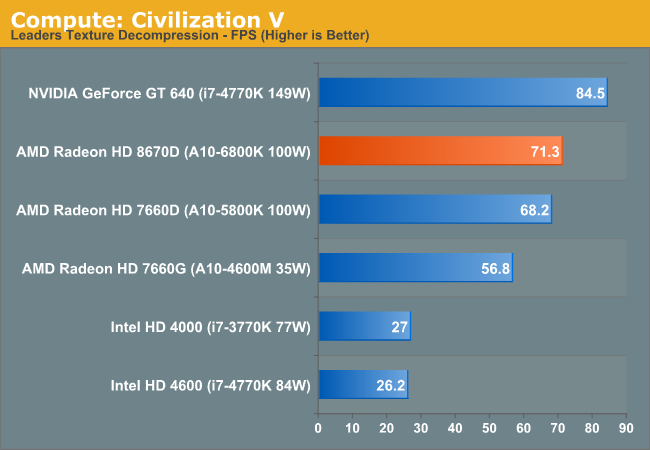
AMD does extremely well in our sole DirectCompute test, outperforming Intel's latest desktop graphics solution by a huge margin.
Our next benchmark is LuxMark2.0, the official benchmark of SmallLuxGPU 2.0. SmallLuxGPU is an OpenCL accelerated ray tracer that is part of the larger LuxRender suite. Ray tracing has become a stronghold for GPUs in recent years as ray tracing maps well to GPU pipelines, allowing artists to render scenes much more quickly than with CPUs alone.
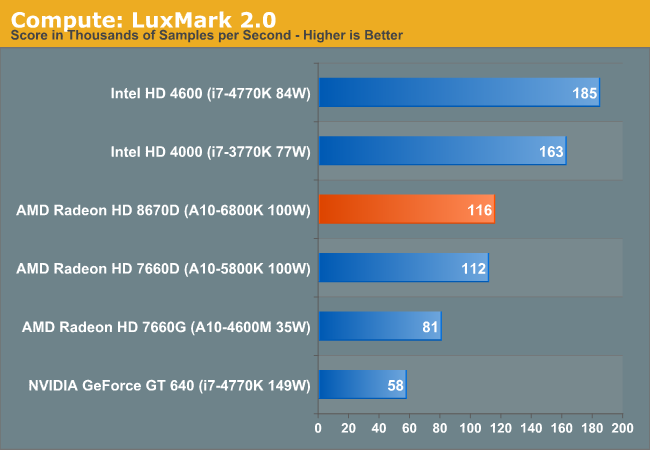
Haswell GT2's OpenCL performance can be very good, which is what we're seeing here. HD 4600 ends up being almost 60% faster than the Radeon HD 8670D.
Our 3rd benchmark set comes from CLBenchmark 1.1. CLBenchmark contains a number of subtests; we’re focusing on the most practical of them, the computer vision test and the fluid simulation test. The former being a useful proxy for computer imaging tasks where systems are required to parse images and identify features (e.g. humans), while fluid simulations are common in professional graphics work and games alike.
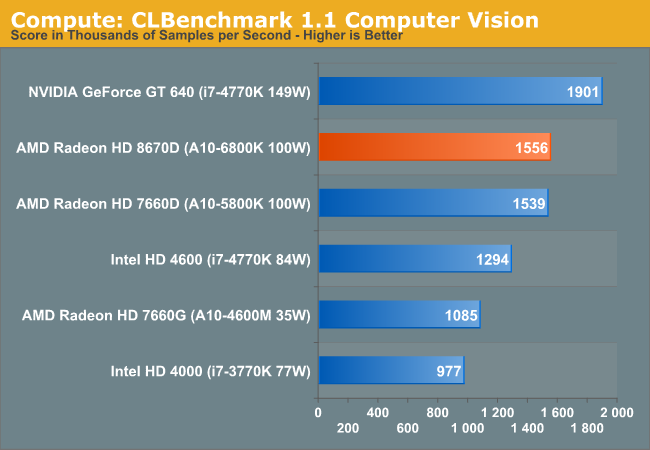
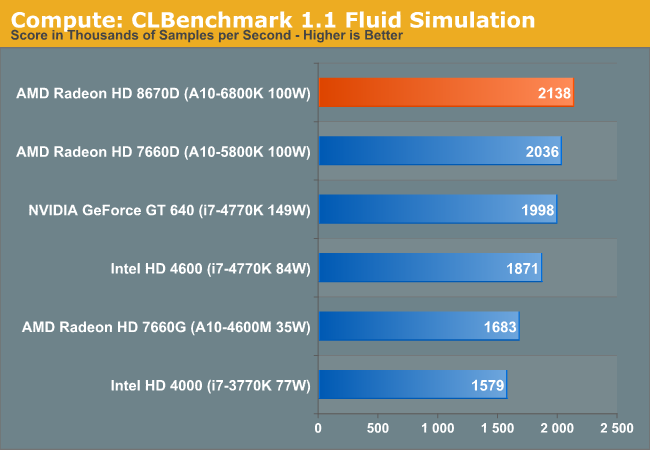
AMD and Intel trade places once again with CLBenchmark. Here, Richland does extremely well.
Our final compute benchmark is Sony Vegas Pro 12, an OpenGL and OpenCL video editing and authoring package. Vegas can use GPUs in a few different ways, the primary uses being to accelerate the video effects and compositing process itself, and in the video encoding step. With video encoding being increasingly offloaded to dedicated DSPs these days we’re focusing on the editing and compositing process, rendering to a low CPU overhead format (XDCAM EX). This specific test comes from Sony, and measures how long it takes to render a video.
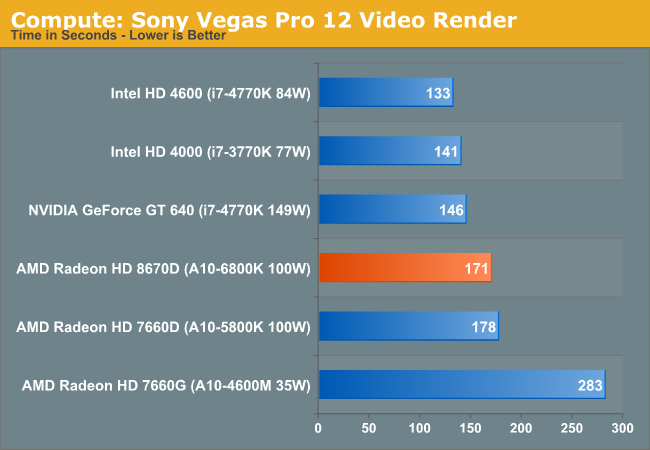
The last compute test goes to Intel, although the two put up a good fight across the entire suite.










102 Comments
View All Comments
BSMonitor - Thursday, June 6, 2013 - link
No, the comparison is absolutely meaningless. You are saying that someone's decision to buy a Core i7 4770 is influenced by the iGPU. It is not.Ortanon - Thursday, June 6, 2013 - link
The comparison isn't for people buying Core i7 lol. You wouldn't need a comparison if you were already going to buy it. The comparison is exactly what it says: Radeon HD 8670D vs. Intel HD 4600.BSMonitor - Thursday, June 6, 2013 - link
That's what I said. He is saying the price between the two should also matter. And as you say, people buying a Core i7 are not comparing iGPUs.BSMonitor - Thursday, June 6, 2013 - link
The comparison in question is not the article... It's the price comparison, go back to the beginning of the thread.silverblue - Thursday, June 6, 2013 - link
Unless you're very much interested in QuickSync, that is.jjj - Thursday, June 6, 2013 - link
1080p monitors can be found even bellow 100$ ,there isn't really a point in reviewing desktop anything bellow 1080p. going lower to find where a game becomes playeble is fine but the review should have 1080p tests even if the products are not good enough.Would be nice if Kaveri would double the SP count but AMD might be going for a smaller die to cut costs given their difficult financial situation. Wouldn't quite match the Xbox in perf but would be close enough and could do a decent job at playing console ports for the next few years.
DigitalFreak - Thursday, June 6, 2013 - link
Why test at a resolution where you're not going to get playable frame rates? If you can only get playable frame rates @ 768p by running medium quality, I'm pretty sure it's going to be unplayable at anything other than low / minimum @ 1080p.jjj - Thursday, June 6, 2013 - link
that's one of the points ,"you are pretty sure" not sure because the review doesn't do it's job to show you for sure and if you want a clear picture you need to look elsewhere.Death666Angel - Thursday, June 6, 2013 - link
Considering that nothing here is playable at 900p, it is quite possible to extrapolate that 1080p won't be playable either. So I'm pretty fine with them not testing it. If you get a $150 APU to play the latest games at 1080p (a resolution much larger than current consoles support in gaming, might I add), you are deluded.britjh22 - Thursday, June 6, 2013 - link
Are the tests currently set up to show higher res but lower detail settings? I know there is a set benchmark settings that they use to normalize, which is fine for high end CPU/mid to high end GPU testing. If I remember correctly the setting, as they climb in "quality" (low, medium, high) increase both resolution and detail concurrently. With Trinity/Richland and eventually Kaveri, it would be interesting to see if these APU's can handle recent games at higher resolution, but lower detail settings. Essentially can you get any recent games to play at common resolutions, even if you have to crank down settings.